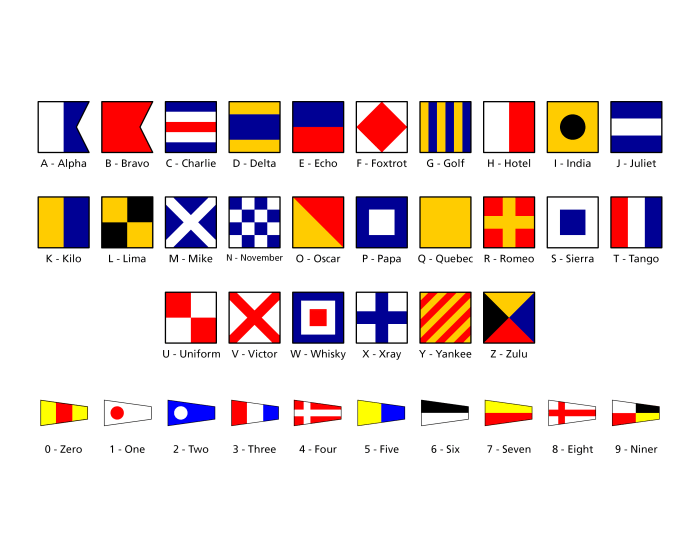Embark on a captivating journey through the realm of U.S. Navy flags and pennants, where vibrant colors, intricate designs, and rich symbolism intertwine to tell a compelling story of maritime heritage, naval traditions, and unwavering patriotism.
From the iconic Stars and Stripes to the specialized pennants that convey messages at sea, each flag and pennant carries a unique purpose and significance, reflecting the proud legacy and unwavering spirit of the U.S. Navy.
Historical Context of U.S. Navy Flags and Pennants

The U.S. Navy flag and pennant system has a rich and storied history, dating back to the founding of the United States. The first official U.S. Navy flag was adopted in 1775, and since then, the system has evolved to include a wide variety of flags and pennants, each with its own unique meaning and purpose.
The significance of the U.S. Navy flag and pennant system cannot be overstated. These flags and pennants are symbols of American naval power and tradition, and they play an important role in communicating with other ships and aircraft.
The First U.S. Navy Flag
The first official U.S. Navy flag was adopted by the Continental Congress on December 3, 1775. The flag was designed by George Washington, and it featured 13 red and white stripes, representing the 13 original colonies. The canton of the flag was blue, and it contained 13 white stars, representing the 13 states.
The U.S. Navy’s flags and pennants are a fascinating subject, steeped in history and symbolism. If you’re interested in exploring the world of philosophy, I highly recommend checking out Think by Simon Blackburn . This thought-provoking book delves into the nature of thinking, knowledge, and reality.
Returning to the topic of U.S. Navy flags and pennants, their intricate designs and vibrant colors are a testament to the rich heritage and pride of the American naval forces.
The first U.S. Navy flag was flown from the masthead of the USS Alfred, the flagship of the Continental Navy. The flag was a symbol of American independence and resolve, and it helped to inspire the American people during the Revolutionary War.
Types and Purposes of U.S. Navy Flags and Pennants
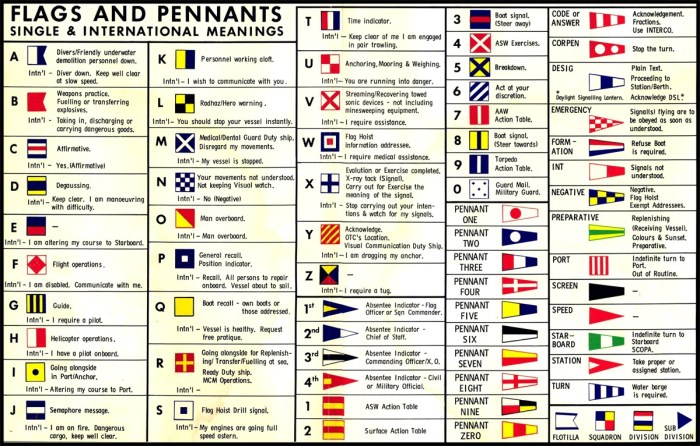
The U.S. Navy employs a comprehensive array of flags and pennants to convey a wide range of messages, both operational and ceremonial. Each type of flag or pennant serves a specific purpose and is used in designated situations.
National Ensign
- Purpose:Represents the United States of America and is flown on all Navy ships and installations.
- Description:Rectangular flag with 13 alternating red and white stripes and 50 white stars on a blue field in the canton.
Commissioning Pennant
- Purpose:Indicates that a ship is in commission, meaning it is fully operational and under the command of the U.S. Navy.
- Description:Long, narrow pennant with a blue field and a white stripe running diagonally from the hoist to the fly.
Jack
- Purpose:Flown at the bow of a ship when it is anchored or moored.
- Description:Square or rectangular flag with the Union Jack in the canton and a blue field with 13 white stars in the fly.
Ensign Staff Pennant
- Purpose:Flown above the National Ensign to indicate the presence of a senior officer aboard.
- Description:Triangular pennant with a blue field and a white stripe running diagonally from the hoist to the fly.
Burgee
- Purpose:Flown by pleasure craft owned by members of the U.S. Navy.
- Description:Triangular flag with a blue field and a white stripe running diagonally from the hoist to the fly.
Signal Flags
- Purpose:Used to communicate messages between ships and shore stations using a standardized code.
- Description:A set of 26 flags, each representing a letter of the alphabet.
Ceremonial Flags
- Purpose:Used during special occasions, such as parades, ceremonies, and holidays.
- Description:A variety of flags, including the President’s Flag, the Secretary of the Navy’s Flag, and the Chief of Naval Operations’ Flag.
Display and Protocol for U.S. Navy Flags and Pennants
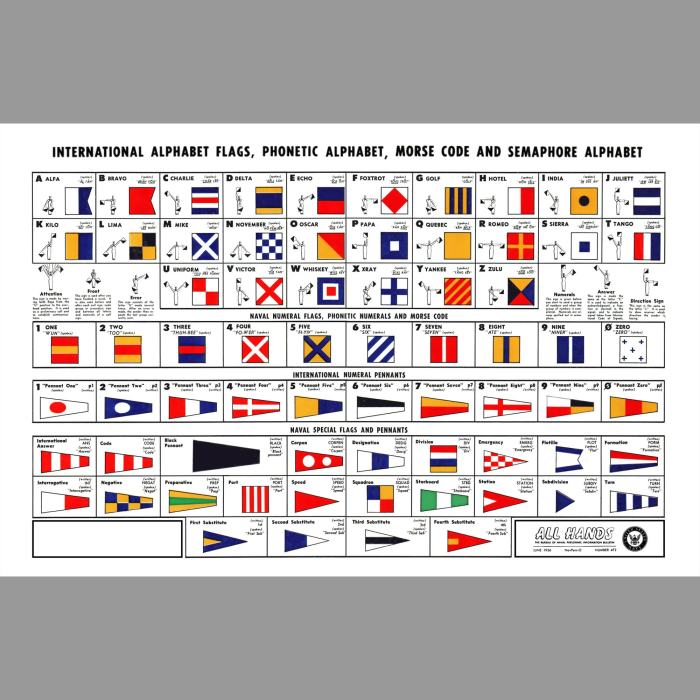
The proper display and handling of U.S. Navy flags and pennants are crucial for maintaining the integrity and respect accorded to these symbols of the nation and the Navy. Strict protocols and regulations govern their use, ensuring that they are displayed with dignity and adherence to established traditions.
Guidelines for Displaying and Handling Flags and Pennants
- Flags should be hoisted briskly and lowered ceremoniously.
- Flags should never touch the ground or be allowed to become soiled or torn.
- Flags should be displayed from sunrise to sunset, unless illuminated at night.
- When not in use, flags should be folded properly and stored in a clean and dry place.
- Pennants should be displayed in accordance with the Navy’s protocol and regulations.
- Flags and pennants should be flown at half-mast as a sign of mourning or respect.
- Flags and pennants should not be used for advertising or commercial purposes.
- Flags and pennants should be treated with the utmost respect and reverence.
Significance and Impact of U.S. Navy Flags and Pennants
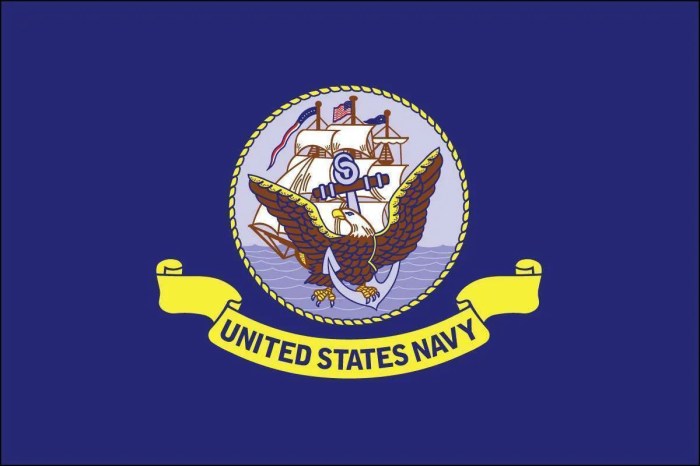
U.S. Navy flags and pennants hold profound historical and cultural significance, symbolizing the nation’s maritime heritage and the courage and dedication of its sailors. These flags and pennants serve as visual representations of the Navy’s traditions, ceremonies, and operations, and have played a pivotal role in shaping the Navy’s identity and its place in the world.
Role in Naval Traditions and Ceremonies, U.s. navy flags and pennants
Flags and pennants are integral to various naval traditions and ceremonies. The ceremonial display of flags and pennants during commissioning ceremonies, change of command ceremonies, and memorial services adds solemnity and grandeur to these events. The display of flags and pennants also serves as a reminder of the Navy’s rich history and the sacrifices made by its members throughout the years.
Significance in Naval Operations
Flags and pennants play a vital role in naval operations. They are used to communicate commands, signals, and information between ships and aircraft. For example, the “Execute” flag is hoisted to signal the commencement of an operation, while the “Prepare to Anchor” flag indicates the ship’s intention to drop anchor.
Flags and pennants also serve as a means of identification, allowing ships and aircraft to recognize and communicate with one another, especially in situations where radio communication is unavailable or unreliable.
Notable Events and Battles
U.S. Navy flags and pennants have been present at some of the most significant events and battles in American history. The “Star-Spangled Banner,” for example, was flown over Fort McHenry during the Battle of Baltimore in 1814, inspiring Francis Scott Key to write the national anthem.
Similarly, the “Jolly Roger” flag was flown by American privateers during the Revolutionary War, symbolizing their determination and willingness to fight for their independence.
Modern Adaptations and Innovations in U.S. Navy Flags and Pennants
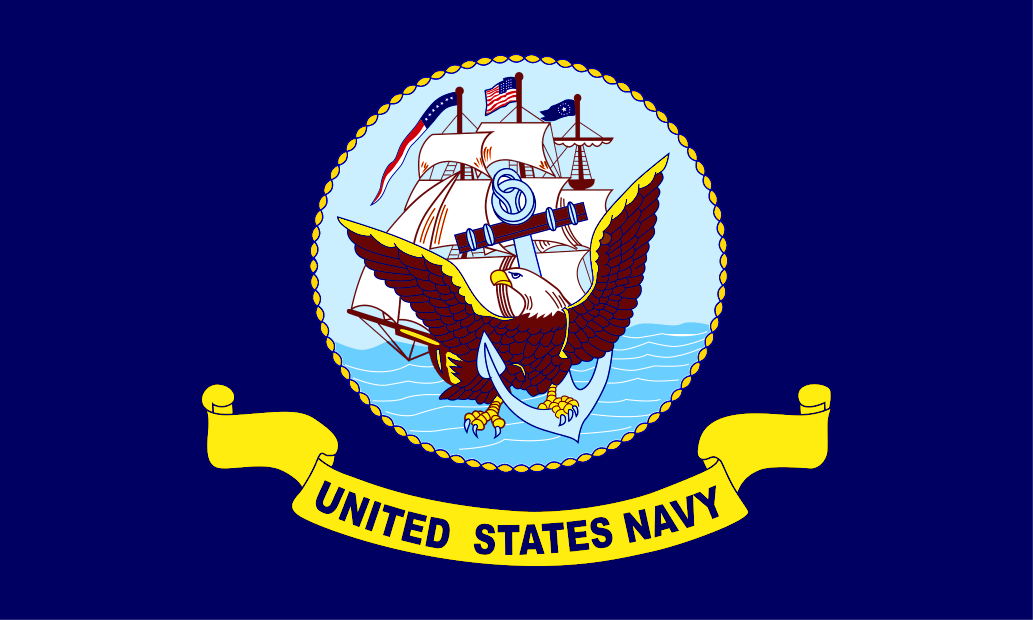
The U.S. Navy has continually adapted its flags and pennants to reflect advancements in technology, operational needs, and cultural changes. Recent innovations have focused on enhancing visibility, improving communication, and reflecting the Navy’s evolving role in modern warfare.
Digital Flags and Pennants
The Navy has introduced digital flags and pennants that utilize LED or LCD technology to display vibrant colors and intricate designs. These digital displays offer improved visibility in low-light conditions and can be programmed to change rapidly, enabling more effective communication and signaling.
Stealth Technology
In response to the increasing threat of electronic warfare, the Navy has developed stealth flags and pennants that minimize radar and infrared signatures. These flags and pennants are made from special materials that absorb or reflect electromagnetic waves, making it difficult for enemy forces to detect and track ships.
Modular Designs
Modular flag and pennant systems allow for greater flexibility and customization. Individual flag and pennant panels can be combined in different configurations to create custom signals or adapt to specific operational scenarios. This modularity enhances the Navy’s ability to communicate effectively in complex and dynamic environments.
Cultural and Historical Adaptations
The Navy has also made adaptations to its flags and pennants to reflect cultural changes and honor its history. For example, the Navy adopted the “Don’t Tread on Me” flag as an official signal flag in 2019, recognizing the historical significance and symbolism of this iconic American symbol.
FAQ Insights
What is the oldest flag flown by the U.S. Navy?
The Grand Union Flag, also known as the Continental Colors, is the oldest flag flown by the U.S. Navy. It was first flown by Commodore Esek Hopkins in 1775.
What is the difference between a flag and a pennant?
A flag is a rectangular piece of cloth that is flown from a staff or mast. A pennant is a triangular or swallow-tailed piece of cloth that is flown from a mast or yardarm.
What is the purpose of a commissioning pennant?
A commissioning pennant is flown from the mainmast of a newly commissioned U.S. Navy ship. It is a symbol of the ship’s official entry into active service.
